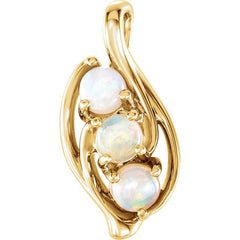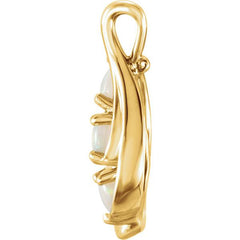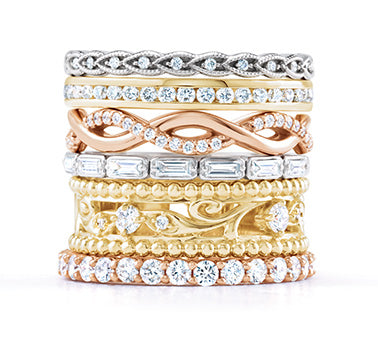Lifetime Warranty
24/7 Hour Customer Service
Free Shipping
30-Day Return
Moijey Fine Jewelry & Diamonds Blog
Opals Are Rainbows You Can Wear!
It’s true, opals possess a brilliant phenomenon called play-of-color, which is a unique display of flashing rainbow colors. Even the name “opal” means to see a change in color from the Greek word “opallios.” Because of the flashing rainbow colors, opals have been cherished to ages.

How remarkable is this opal? It's pretty easy to see why it was and is still cherished.
People all over the world associated opals with good luck and everything positive until the 1820s when a rumor spread that opal was considered unlucky except for people born in October.
When I was studying to be a Graduate Gemologist with GIA, I learned how that rumor started. It turns out to be simply that. A rumor.
In 1829, Scottish novelist Sir Walter Scott wrote a novel called Anne of Geierstein or Maiden of the Mist. The book has a piece of opal jewelry that is demonically possessed and eventually destroyed with holy water. So far, the book is a delightful action adventure story. I recommend it if any of you wonderful readers are looking for something else to read after this equally wonderful article.

Brilliant book, but it gave opal an undeserved bad reputation.
In all seriousness though, long before that book was ever published, opal has been praised and beloved not only for their beautiful rainbow colors, but for its symbolism of good fortune, faith, and hope. I think we can all agree that any jewelry with those qualities is quite brilliant. Like this Tiffany Necklace from the Smithsonian. You read that correctly, that is from Tiffany. The Tiffany.

Isn't this necklace beautiful? I heard someone at the Smithsonian call this "Mermaid Jewelry." Another delightful name for a Tiffany Necklace.
Wonderful. We now know that the unlucky opal story is rubbish. But how on earth (or in Earth) did opals get their spectacular colors?
The magnificent rainbow stone formed in the earth millions of years ago in the silica-rich soil. Opals from Australia are a result of seasonal rains, which soaked into the ground, carrying dissolved silica deeper into the earth. During the dry periods, the water from the rains evaporated and left behind silica deposits between the cracks and layers of sedimentary rock. The solidified silica eventually became the opal we all know and adore today.
Despite the solid silica form, opal still contains about 3% to 20% water in its structure. That’s why, as a gemologist, I suggest that you treat your opals carefully. Wear opals as either necklaces, earrings, or brooches. And be sure to keep them moist. If opals dry out, they will develop crazing, cracks that resemble a spider's web in the structure. Crazing can also happen under excessive or direct lighting. Even the sweet opals in our Three-Stone Opal Pendant needs to be protected from losing moisture.


A lovely trio of opals, aren't they?
Opal is made from billions of submicroscopic spheres in a uniform arrangement. Under an electron microscope, specifically under 30,000x magnification, you can see the silica spheres neatly arranged in a three-dimensional grid. Even though the pattern is uniform, the sizes of the silica spheres are different sizes. How big or how small the spheres are in the opal varies the play - of - color we see dancing in the stone. Silica spheres that measure 0.1 micron (one ten-millionth of a meter) in diameter produces violet and spheres roughly 0.2 microns creates red. The sizes in between create the rest of the rainbow.

That remarkable picture came from a special microscope. What a cool world we live in today.
You know what else is pretty neat about opals? The silica responsible for producing opal can also form in spaces around wood, seashells, and skeletons. This results in opalized fossils. The Smithsonian has an opalized vertebra on display with remarkable play-of-color.

This vertebra is incredible to behold. It's a challenge to capture the play-of-color on a phone camera.
There’s even an opalized pliosaur on display in Australia at the National Opal Collection in Sydney. I am not surprised that Austrailia has a national collection of opal. I can only imagine how remarkable that collection must be in person. Okay, now I have an addition to my Bucket List: see opalized fossils in Australia. That and the opal mines in Lightning Ridge, Australia. That is the primary source of exquisite opals. The outback has plenty of silica, raining seasons, and dry spells which are perfect for producing opal.

I would love to see this in person. Wouldn't you?
Next week, I will go into more detail about how opals have different background colors and patterns. Thank you for stopping by and have a great weekend!
Opals Are Rainbows You Can Wear!
It’s true, opals possess a brilliant phenomenon called play-of-color, which is a unique display of flashing rainbow colors. Even the name “opal” means to see a change in color from the Greek word “opallios.” Because of the flashing rainbow colors, opals have been cherished to ages.

How remarkable is this opal? It's pretty easy to see why it was and is still cherished.
People all over the world associated opals with good luck and everything positive until the 1820s when a rumor spread that opal was considered unlucky except for people born in October.
When I was studying to be a Graduate Gemologist with GIA, I learned how that rumor started. It turns out to be simply that. A rumor.
In 1829, Scottish novelist Sir Walter Scott wrote a novel called Anne of Geierstein or Maiden of the Mist. The book has a piece of opal jewelry that is demonically possessed and eventually destroyed with holy water. So far, the book is a delightful action adventure story. I recommend it if any of you wonderful readers are looking for something else to read after this equally wonderful article.
Brilliant book, but it gave opal an undeserved bad reputation.
In all seriousness though, long before that book was ever published, opal has been praised and beloved not only for their beautiful rainbow colors, but for its symbolism of good fortune, faith, and hope. I think we can all agree that any jewelry with those qualities is quite brilliant. Like this Tiffany Necklace from the Smithsonian. You read that correctly, that is from Tiffany. The Tiffany.
Isn't this necklace beautiful? I heard someone at the Smithsonian call this "Mermaid Jewelry." Another delightful name for a Tiffany Necklace.
Wonderful. We now know that the unlucky opal story is rubbish. But how on earth (or in Earth) did opals get their spectacular colors?
The magnificent rainbow stone formed in the earth millions of years ago in the silica-rich soil. Opals from Australia are a result of seasonal rains, which soaked into the ground, carrying dissolved silica deeper into the earth. During the dry periods, the water from the rains evaporated and left behind silica deposits between the cracks and layers of sedimentary rock. The solidified silica eventually became the opal we all know and adore today.
Despite the solid silica form, opal still contains about 3% to 20% water in its structure. That’s why, as a gemologist, I suggest that you treat your opals carefully. Wear opals as either necklaces, earrings, or brooches. And be sure to keep them moist. If opals dry out, they will develop crazing, cracks that resemble a spider's web in the structure. Crazing can also happen under excessive or direct lighting. Even the sweet opals in our Three-Stone Opal Pendant needs to be protected from losing moisture.


A lovely trio of opals, aren't they?
Opal is made from billions of submicroscopic spheres in a uniform arrangement. Under an electron microscope, specifically under 30,000x magnification, you can see the silica spheres neatly arranged in a three-dimensional grid. Even though the pattern is uniform, the sizes of the silica spheres are different sizes. How big or how small the spheres are in the opal varies the play - of - color we see dancing in the stone. Silica spheres that measure 0.1 micron (one ten-millionth of a meter) in diameter produces violet and spheres roughly 0.2 microns creates red. The sizes in between create the rest of the rainbow.

That remarkable picture came from a special microscope. What a cool world we live in today.
You know what else is pretty neat about opals? The silica responsible for producing opal can also form in spaces around wood, seashells, and skeletons. This results in opalized fossils. The Smithsonian has an opalized vertebra on display with remarkable play-of-color.

This vertebra is incredible to behold. It's a challenge to capture the play-of-color on a phone camera.
There’s even an opalized pliosaur on display in Australia at the National Opal Collection in Sydney. I am not surprised that Austrailia has a national collection of opal. I can only imagine how remarkable that collection must be in person. Okay, now I have an addition to my Bucket List: see opalized fossils in Australia. That and the opal mines in Lightning Ridge, Australia. That is the primary source of exquisite opals. The outback has plenty of silica, raining seasons, and dry spells which are perfect for producing opal.

I would love to see this in person. Wouldn't you?
Next week, I will go into more detail about how opals have different background colors and patterns. Thank you for stopping by and have a great weekend!






